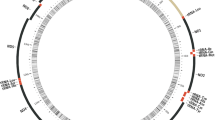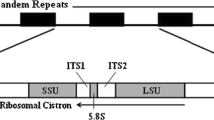Abstract
The complete mitochondrial genome of the eastern oyster Crassostrea virginica (GenBank accession number AY905542) is 17,243 bp in length and contains 2 ribosomal genes, 12 protein-coding genes, and 23 transfer RNAs. The arrangement of protein-coding genes is identical to that of the congeneric Pacific oyster C. gigas, but tRNA genes show several duplications and extensive rearrangements between the species. Unique features in C. virginica include an additional trnM gene, the absence of an ATPase subunit 8 (atp8) gene, and an inferred translational frameshift within the cytochrome b (cob) gene. In both species the large subunit ribosomal RNA gene is encoded by 2 separate regions of the mitochondrial genome, the first reported case of a split ribosomal RNA gene in a metazoan. Translation of protein-coding genes in both species is initiated with methionine, with the exception of cob, which uses leucine. In C. virginica translation of all protein-coding genes (except possibly cob) terminates with TAA, with polyadenylation completing the primary transcript in cytochrome oxidase subunit III (cox3) and NADH dehydrogenase subunit 4L (nad4L), whereas C. gigas employs stop codons TAA and TAG equally. Interspecific divergence of mitochondrially encoded proteins is considerable, with amino acid identities ranging from 47% to 92%. A single major noncoding region representing the putative control region is found in both species.







Similar content being viewed by others

References
Avise JC (2000). Phylogeography: The History and Formation of Species. (Cambridge, Mass: Harvard University Press)
Beaudoing E, Gautheret D (2001) Identification of alternate polyadenylation sites and analysis of their tissue distribution using EST data. Genome Res 11: 1520–1526
Beckenbach AT, Robson SKA, Crozier RH (2005) Single nucleotide +1 frameshifts in an apparently functional mitochondrial cytochrome b gene in ants of the genus Polyrhachis. J Mol Evol 60: 141–152
Boore JL (1999) Animal mitochondrial genomes. Nucleic Acids Res 27: 1767–1780
Boore JL, Brown WM (1994) Complete DNA sequence of the mitochondrial genome of the black chiton, Katharina tunicata. Genetics 138: 423–443
Boore JL, Medina M Rosenberg LA (2004) Complete sequences of the highly rearranged molluscan mitochondrial genomes of the scaphopod Graptacme eborea and the bivalve Mytilus edulis. Mol Biol Evol 21: 1492–1503
Brown WM, (1985) The mitochondrial genome of animals. In: Molecular Evolutionary Genetics, MacIntyre RJ (ed). (New York, NY: Plenum Press), pp 95–130
Cannone JJ, Subramanian S, Schnare MN, Collett JR, D’Souza LM, Du Y, Feng B, Lin N, Madabusi LV, Muller KM, Pande N, Shang Z, Yu N, Gutell RR (2002). The Comparative RNA Web (CRW) Site: An online database of comparative sequence and structure information for ribosomal, intron, and other RNAs. BioMed Central Bioinformatics 3: 2
Cardon LR, Burge C, Clayton DW, Karlin S (1994) Pervasive CpG suppression in animal mitochondrial genomes. Proc Natl Acad Sci USA 91: 3799–3803
Farabaugh PJ (1996) Programmed translational frameshifting. Annu Rev Genet 30, 507–528
Gissi C, Pesole G (2003) Transcript mapping and genome annotation of ascidian mtDNA using EST data. Genome Res 13: 2203–2212
Gissi C, Iannelli F, Pesole G (2004) Complete mtDNA of Ciona intestinalis reveals extensive gene rearrangement and the presence of an atp8 and an extra trnM gene in ascidians. J Mol Evol 58: 376–389
Gueguen Y, Cadoret JP, Flament D, Barreau-Roumiguière C, Girardot AL, Garniera J, Hoareaua A, Bachère E, Escoubas JM (2003) Immune gene discovery by expressed sequence tags generated from hemocytes of the bacteria-challenged oyster, Crassostrea gigas. Gene 303: 139–145
Helfenbein KG, Brown WM, Boore JL (2001) The complete mitochondrial genome of the articulate brachiopod Terebratalia transversa. Mol Biol Evol 18: 1734–1744
Hoffmann RJ, Boore JL, Brown WM (1992). A novel mitochondrial genome organization for the blue mussel, Mytilus edulis. Genetics 131: 397–412
Jameson D, Gibson AP, Hudelot C, Higgs PG (2003) OGRe: a relational database for comparative analysis of mitochondrial genomes. Nucleic Acids Res 31: 202–206
Jenny MJ, Ringwood AH, Lacy ER, Lewitus AJ, Kempton JW, Gross PS, Warr GW, Chapman RW (2002) Potential indicators of stress response identified by expressed sequence tag analysis of hemocytes and embryos from the American oyster, Crassostrea virginica. Mar Biotechnol 4: 81–93
Kuwahara R, Oohara I (2001). Variability of two major non-coding regions of the Japanese oyster Crassostrea gigas mitochondrial DNA. Bull Nat Res Inst Fish Sci 16: 97–101
Lowe TM, Eddy SR (1997) tRNAscan-SE: a program for improved detection of transfer RNA genes in genomic sequence. Nucleic Acids Res 25: 955–964
Milbury CA, (2003) Using mitochondrial DNA markers to monitor oyster stock enhancement in the Choptank River, Chesapeake Bay. M.S. thesis, College of Marine Studies, University of Delaware, Lewes
Milbury CA, Gaffney PM, Meritt DW, Newell RIE (2004) Mitochondrial DNA markers allow monitoring of oyster stock enhancement in the Chesapeake Bay. Mar Biol 145: 351–359
Mindell DP, Sorenson MD, Dimcheff DE (1998) An extra nucleotide is not translated in mitochondrial ND3 of some birds and turtles. Mol Biol Evol 15: 1568–1571
Newell RIE (1988). Ecological changes in Chesapeake Bay: are they the result of overharvesting the American oyster, Crassostrea virginica? In: Understanding the Estuary: Advances in Chesapeake Bay Research, Vol. 129, Lynch MP, Krome EC (eds). (Gloucester Point, VA: Chesapeake Research Consortium) pp 536–546
Peatman EJ, Wei X, Feng J, Liu LL, Kucuktas H, Li P, He C, Rouse D, Wallace R, Dunham R, Liu Z (2004). Development of expressed sequence tags from eastern oyster (Crassostrea virginica): lessons learned from previous efforts. Mar Biotechnol 6S, 491–496
Perna NT, Kocher TD (1995) Patterns of nucleotide composition at fourfold degenerate sites of animal mitochondrial genomes. J Mol Evol 41: 353–358
Rafferty GP, Powell R (2002) Identification of genes expressed in the gill tissue of the Pacific oyster (Crassostrea gigas) using expressed-sequence tags. J Mollusc Stud 68: 397-399
Rawlings TA, Collins TM, Bieler R (2001) A major mitochondrial gene rearrangement among closely related species. Mol Biol Evol 18: 1604–1609
Reeb CA, Avise JC (1990) A genetic discontinuity in a continuously distributed species: mitochondrial DNA in the American oyster, Crassostrea virginica. Genetics 124: 397–406
Roberti M, Polosa PL, Bruni F, Musicco C, Gadaleta MN, Cantatore P (2003). DmTTF, a novel mitochondrial transcription termination factor that recognises two sequences of Drosophila melanogaster mitochondrial DNA. Nucleic Acids Res 31: 1597–1604
Rothschild BJ, Ault JS, Goulletquer P, Héral M (1994). Decline of the Chesapeake Bay oyster population: a century of habitat destruction and overfishing. Mar Ecol Prog Ser 111: 29–39
Serb JM, Lydeard C (2003) Complete mtDNA sequence of the North American freshwater mussel, Lampsilis ornata (Unionidae): An examination of the evolution and phylogenetic utility of mitochondrial genome organization in Bivalvia (Mollusca). Mol Biol Evol 20: 1854–1866
Shearer TL, Van Oppen MJH, Romano SL, Wörheide G (2002) Slow mitochondrial DNA sequence evolution in the Anthozoa (Cnidaria). Oceanogr Mar Biol Annu Rev 11: 2475–2487
Stothard P (2000) The Sequence Manipulation Suite: JavaScript programs for analyzing and formatting protein and DNA sequences. BioTechniques 28: 1102–1104
Valverde JR, Marco R, Garesse R (1994) A conserved heptamer motif for ribosomal RNA transcription termination in animal mitochondria. Proc Natl Acad Sci USA 91: 5368–5371
Wakefield JR, Gaffney PM (1996). DGGE reveals additional population structure in American oyster (Crassostrea virginica) populations. J Shellfish Res 15: 513
Wolstenholme DR (1992) Animal mitochondrial DNA: structure and evolution. Int Rev Cytol 141: 173–216
Wolstenholme D, MacFarlane JL, Okimoto R, Clary DO, Wahleithner JA (1987) Bizarre tRNAs inferred from DNA sequences of mitochondrial genomes of nematode worms. Proc Natl Acad Sci USA 84: 1324–1328
Wyman SK, Jansen RK, Boore JL (2004) Automatic annotation of organellar genomes with DOGMA. Bioinformatics 20: 3252–3254
Yokobori SI, Fukuda N, Nakamura M, Aoyama T, Oshima T (2004) Long-term conservation of six duplicated structural genes in cephalopod mitochondrial genomes. Mol Biol Evol 21: 2034–2046
Acknowledgments
We thank Robin Gutell and Jamie Cannone for assistance in discovering the split rrnL gene, and Jeffrey Boore for help in analyzing the cob translational frameshifting. This work was supported by Delaware Sea Grant and the NOAA Oyster Disease Research Program.
Author information
Authors and Affiliations
Corresponding author
Appendix
Appendix
Rights and permissions
About this article
Cite this article
Milbury, C.A., Gaffney, P.M. Complete Mitochondrial DNA Sequence of the Eastern Oyster Crassostrea virginica. Mar Biotechnol 7, 697–712 (2005). https://doi.org/10.1007/s10126-005-0004-0
Received:
Accepted:
Published:
Issue Date:
DOI: https://doi.org/10.1007/s10126-005-0004-0



